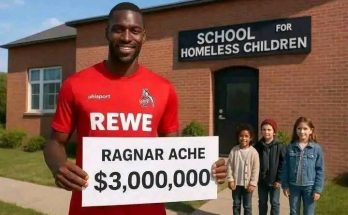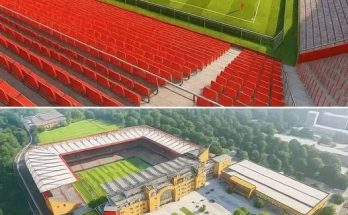Shohei Ohtani, MLB’s transcendent two‑way sensation, is set to take the mound once more this Sunday as the Los Angeles Dodgers host the Washington Nationals at Dodger Stadium. This will mark his second pitching appearance since undergoing Tommy John revision surgery in September 2023, and the stakes couldn’t be higher for both the 30‑year‑old phenom and a Dodgers pitching staff in dire need of healthy arms. washingtonpost.com+15reuters.com+15apnews.com+15
Ohtani’s return to pitching earlier this week against the San Diego Padres generated a seismic buzz across baseball. His first inning on the mound—just 28 pitches—saw him touch 100.2 mph on the radar gun, surrender one run on two hits, and issue no walks or strikeouts. Though brief, it was a flurry of promise for a player who hasn’t pitched in a major‑league game since August 23, 2023.
Manager Dave Roberts, cautious but optimistic, crafted a slow‑build plan for Ohtani’s reintegration into the rotation. Starting with one inning, the plan is to expand incrementally, adding another inning or two each outing. Sunday’s start is designed to follow that blueprint: a measured, cautious step in ramping Ohtani back to full strength. as.com
But the context magnifies the significance. The Dodgers have endured a slew of injuries this season—starting arms decimated—and lost Clayton Kershaw, Roki Sasaki, Blake Snell, and Tyler Glasnow to various ailments. Ohtani can’t fix all that, but his capacity to throw once‑a‑week while hitting every game provides roster flexibility and bullpen relief. His dual capacity is a luxury no other team can boast. the-sun.com
Sunday’s matchup at 1:10 p.m. PT will serve as the finale to a three‑game weekend set. Ohtani will oppose a Nationals team whose offense has recently stirred to life, snapping an 11‑game losing skid with a dramatic extra‑innings win on Friday. Though their overall record remains poor, the Nationals have shown signs of fight, buoyed by the emergence of rookie James Wood, who belted his 20th home run in Friday’s victory. washingtonpost.com
Dodger Stadium is expected to deliver one of its larger crowds of the month. A global star interests fans beyond Los Angeles, and Ohtani throwing again stirs a unique cross‑continental energy. Japan fans follow intently, ESPN and MLB.tv will televise, and scouts, analysts, and executives from across baseball will be tuning in. The atmosphere—both internal and external—will be electric.
The return: context and expectations
Ohtani’s rupture of the ulnar collateral ligament in 2023 was the impetus for his transformative deal with the Dodgers: a 10‑year, $700 million commitment in December. The deal was anchored by his hitting prowess—already elite—and his projected return to two‑way form. The Dodgers were confident that Ohtani’s history with Tommy John surgery (first in 2018) meant a resilient comeback. apnews.com
Despite skipping the mound in 2024, Ohtani delivered a historic NL MVP campaign: 54 homers, 59 steals, and a World Series title. The Dodgers’ gamble paid off: they secured the championship and a superstar who performed at an MVP level without pitching. Now, their return investment depends on what Ohtani contributes as a starter. en.wikipedia.org+15apnews.com+15the-sun.com+15
Over the past two weeks, Ohtani has gradually increased throwing activity, hitting the 100 mph threshold and blending velocity with functional command. His bullpen sessions built confidence; his hit double against San Diego showed off the seamless transition from pitcher to hitter; and Monday’s game confirmed the Dodgers’ desire to break convention by assigning him real MLB innings rather than a standard rehab stint. washingtonpost.com+1wsj.com+1
A handful of innings won’t carry statistical weight in the rotation, or earn a win in the standings—but they’ll educate coaches, trainers, and Ohtani himself. How does his arm react to game stress? Does he recover between outings? Can he maintain triple‑digit radar over multiple frames? Experience in live competition is more valuable than any spring outing.
Manager Roberts has kept an open dialogue, hinting at flexibility: perhaps two innings Sunday, perhaps less. The goal is daily progress, not cumulative mileage. A misstep this weekend would force recalibration; success would warrant gradual elevation toward mid‑rotation expectations.
What Sunday means for the Dodgers and Ohtani
For the Dodgers, Sunday is not merely a chance to collect innings—it’s a morale inflection point. Their rotation has felt unstable without Kershaw and full health; addition of Ohtani’s arm, even in limited form, gives structure and hope. The hope is twofold: that Ohtani can shorten games and the bullpen, and that his presence steadies a fragile staff.
On the hitting side, Ohtani continues crushing baseball, posting an OPS north of .900 and pacing among the league leaders in home runs and stolen bases. He remains a legendary threat. Now, his Sunday appearance offers MLB a live experiment in long‑term load management: can he sustain high‑end pitching and hitting in a single calendar? If he succeeds, baseball as a two‑way showcase could extend beyond rare exceptions.
For Ohtani personally, this outing crystallizes months of work: rehab, pain management, bullpen track, psychological resilience. Every inning, every at‑bat, answers a question: can he once again bear the physical toll of both roles? A strong outing validates his faith; a stumble raises questions—but perhaps also reveals what still needs refinement.
The Nationals edge in
While all attention centers on Ohtani, the Nationals aren’t a pushover. Their lineup has shown spark recently, with rookies like James Wood injecting youth and power. Friday’s extra‑innings win showed they can rattle off offense even in lulls, and they’ll see facing Ohtani as a statement game. They may rotate their lineup to optimize against his first pitches, but baseball history teaches even feeble teams can rise for star matchups.
Still, Ohtani’s velocity overshadows most batters. Nationals hitters will face fastballs over 99 mph mixed with sharp offspeed pitches. Their adaptability, discipline, and finish will determine how imposing Ohtani truly is in his next test.
Scouting the pitching plan
Radar guns aren’t everything—grab‑and‑go velocity still requires consistent control. Ohtani’s Monday outing saw 16 strikes out of 28 pitches; his curve and splitter had movement, but command was shaky. The Dodgers likely bushel some fastballs early to regain feel, then incrementally bring in breaking offerings as he stretches.
If Ohtani lasts into a second inning, expect 40–50 total pitches. That projection gives him a chance to hit mechanical stride without tripping thresholds. The key metrics: spin rate, movement, release consistency. Dodgers analytics, trainers, and Ohtani’s own feedback will make final decisions for future starts.
Managing the boom‑or‑bust narrative
Public expectation remains lofty: critics and fans alike want a glimpse of greatness. But Roberts and the Dodgers are under no illusion. This is risk management. A playoff push is helped, not hurt, by Ohtani’s return—but his health matters more. One elbow hitch could bench him again for a year. So while excitement percolates, caution governs.
In practical terms, Sunday’s start is a data gathering mission. Scouts and cameras will follow every spin‑axis, each stride, every reaction. Dodgers’ front office sees data from Germany to Japan. MLB will chart velocities, exit velos, spin metrics; media chatter will swirl.
But for Ohtani? He sees family, friends, a once empty mound, and offers roughly 90 pitches of code-data and emotion. He’s done 28. Now he’s on to 50 if all goes well.
The larger narrative: redefining two‑way baseball
Ohtani’s dual success reshapes how top talent is valued. His performance poses questions: must elite hitters specialize early? Can teams develop multi‑tool athletes? Sunday’s outing extends that narrative arc: he’s not just hitting in interleague games; he’s imposing on opposing lineups as a pitcher. If he delivers, his legacy grows; if he falters, baseball will learn how far two‑way can stretch.
Dodgers benefit not just in wins, but in economics—average ticket prices surge when Ohtani pitches; jersey sales spike; TV ratings climb. Last Monday’s game saw viewership peaks near 100 mph pitches. Sunday could eclipse them.
But beyond cash and ratings, there’s pure metaphysics: Ohtani stands as baseball’s current iconic alchemy. He blends grace and power, East and West, pitching and hitting. Every time he takes the mound again, the sport’s horizons tilt. Sunday is more than a game—it’s a chapter in baseball evolution.
Pivotal moments to watch
-
First inning command: Does he find the strike zone quickly, or labor on borderline pitches?
-
Velocity depth: Can he maintain 98‑100 mph deep into the inning, or fade to 95?
-
Second inning viability: If he gets there, can he complete a double‑digit pitch amount?
-
Bullpen transition: How smoothly does the Dodgers’ pen manage the shift from starter?
-
Post‑game recovery: How does his arm feel post‑outing? That may be the best signal of future ramp‑up.
Setting the context in real time
Sunday brings more than a pitching test—it’s a confluence of storylines:
-
Ohtani’s legacy: A second Tommy John comeback would certify his durability.
-
Dodgers’ rotation: Can this outing ease their current strain?
-
Nationals hurdle: Can they claim a marquee victory and shake early season woes?
-
Baseball culture: Does two‑way truly have sustained viability?
Birds‑eye and yellow‑hawk assessments aside, the fans will fill Dodger Stadium, the cameras will roll, and 155 mph fastballs will register not in speed, but in expectation. Sunday’s game, regardless of outcome, will add a footnote to baseball’s living history, where Shohei Ohtani keeps expanding the playbook.
Final thoughts
Ohtani’s Sunday start is about more than earned runs or strikeouts. It’s about resilience, reconstruction, and rewriting the limits of modern athleticism. Every pitch, swing, inning, run back to the dugout—weaves into a story larger than sports. Will he dominate? Will he stumble? We’ll find out.
What is certain is this: Dodger Stadium will feel his return not just inmph, but in wonder. Baseball will feel it across nations and networks. And for Ohtani, Sunday is another milestone—another challenge in a journey that’s still unfolding. If all goes well, it’ll be another thread in the tapestry of his already mythic career. If not, there will still be lessons for the volume ahead.
But maybe best of all, Sunday marks the day one of baseball’s greatest ever two‑way talents stepped on the mound again—and that, above all else, is why we watch.



